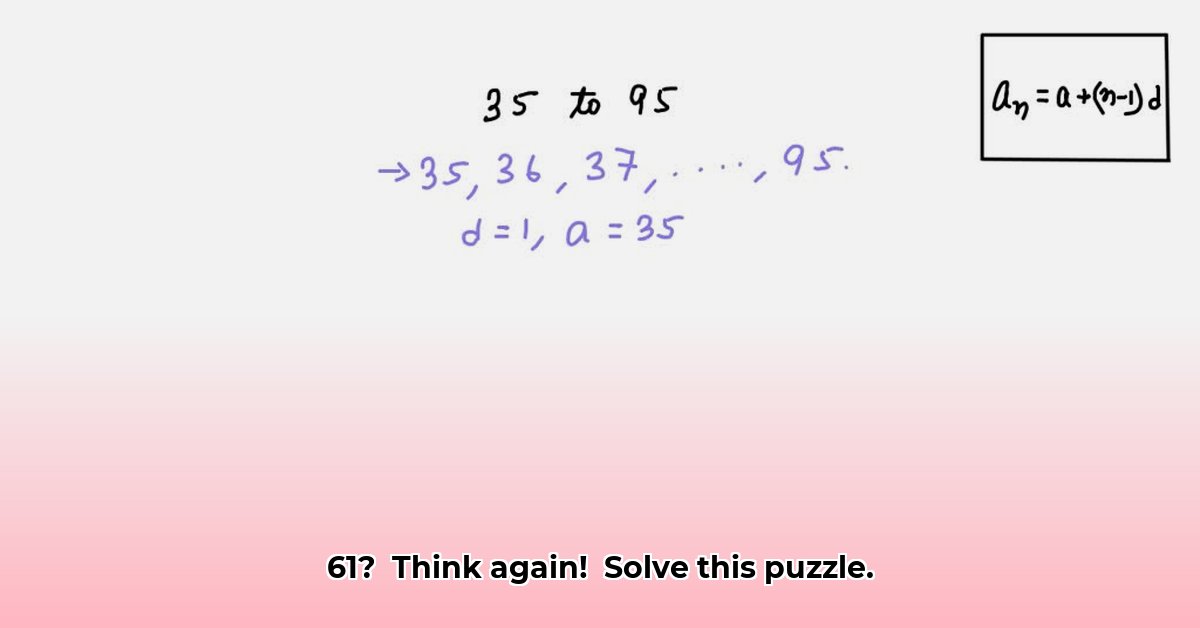
Understanding the Problem: Counting Integers in a Range
This instructional guide explains how to determine the number of integers (whole numbers) within a specified range. We'll focus on the range from 35 to 95, inclusive (meaning both 35 and 95 are included). This seemingly simple problem provides a valuable opportunity to explore multiple solution methods and address common misunderstandings students encounter. Understanding this concept is foundational for more advanced mathematical topics.
Method 1: Direct Subtraction with Adjustment
The most efficient approach utilizes subtraction and a crucial adjustment.
Find the difference: Subtract the lower bound from the upper bound: 95 - 35 = 60. This calculation provides the number of integers between 35 and 95.
Add one: Since the question specifies an inclusive range (including both 35 and 95), we must add 1 to the difference. This accounts for the starting point (35), which is often overlooked.
Final Answer: 60 + 1 = 61. Therefore, there are 61 integers in the range 35 to 95 inclusive.
Method 2: Visual Representation using a Number Line
A number line provides a clear visual representation of the problem. Draw a number line and mark the integers 35 through 95. Counting these marks directly demonstrates there are 61 integers. This visual method is particularly useful for students who benefit from concrete representations of abstract concepts. The visual reinforces the necessity of adding 1 to the difference between 95 and 35.
Addressing Common Misconceptions
A frequent error is neglecting to add 1 to the difference. Students may correctly calculate 95 - 35 = 60 but fail to account for the inclusion of both endpoints, leading to an incorrect answer. Emphasize the distinction between inclusive ranges (including both endpoints) and exclusive ranges (excluding one or both).
Another potential misconception involves misinterpreting the term "integer." Clearly define that integers are whole numbers, including positive, negative, and zero. In this case, the focus is on positive whole numbers.
Practice Problems
Test your newly acquired skills with these problems:
How many integers are there from 12 to 42, inclusive?
Calculate the number of integers between -10 and 10, inclusive.
How many integers are there from 200 to 300, exclusive of 200 but inclusive of 300?
Solutions to Practice Problems
- 31
- 21
- 100
Pedagogical Implications: Teaching Strategies
Effective teaching involves presenting concepts in multiple ways, catering to diverse learning styles. The combination of direct calculation, visual aids such as the number line, and practice problems facilitates deeper understanding and retention. Identifying and addressing common misconceptions is crucial for student success. Careful attention to terminology, such as "inclusive" and "exclusive," is also critical for ensuring accurate interpretation of problems. Curriculum should include a variety of problem types, progressing from simple to more challenging examples.
Conclusion
Understanding how to count integers in a range is a foundational skill in mathematics. By mastering this concept and understanding the various solution methods and common pitfalls, students lay a strong groundwork for more advanced mathematical concepts.